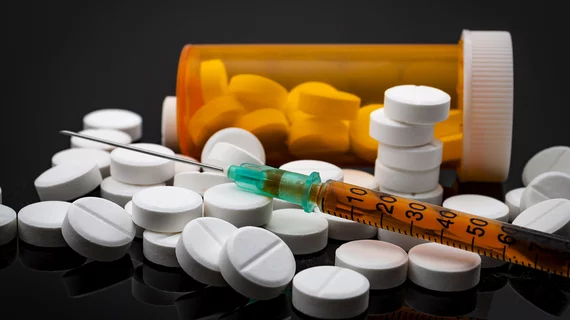Opioid overdose deaths to increase 147% by 2025
The opioid overdose epidemic, which resulted in 48,000 deaths in 2017, isn't getting better anytime soon, according to recent research published in JAMA.
That's because interventions that target prescription opioid misuse, including prescription monitoring programs, may only have a small impact on the number of opioid deaths in the future, Boston researchers found.
“Deaths due to opioid overdose have tripled in the last decade,” wrote lead author Jagpreet Chhatwal, PhD, of Massachusetts General Hospital in Boston, and colleagues. “Efforts to curb this trend have focused on restricting the prescription opioid supply; however, the near-term effects of such efforts are unknown.”
Chhatwal and colleagues sought to determine the effects of interventions to reduce prescription opioid misuse on fatalities. They found the misuse and overdose epidemic is largely caused by three factors: rising illicit use of opioids, direct initiation of opioid use with illicit opioids, and a rapid increase in illicit opioid lethality. Current interventions that target prescription opioids will have little impact on the rise in illicit opioid misuse and overdose.
Opioid overdose deaths will likely rise from 2016 to 2025––a total of 700,400 individuals will die from opioid overdose over that timeframe, according to the study. Under current interventions, the annual number of opioid overdose deaths will increase from 33,100 to 81,700 in 2025—a 147 percent jump since 2015.
Alarmingly, 80 percent of those deaths will be attributed to illicit opioids, as overdose deaths from illicit opioids are projected to increase 259 percent, to nearly 70,000, in 2025, the study found. The number of individuals using illicit opioids is projected to increase 61 percent by 2025.
Researchers used data from the National Survey on Drug Use and Health (NSDUH), the CDC and elsewhere to develop a mathematical model—the Opioid Policy Model—to simulate the opioid overdose crisis in the U.S. from 2002 to 2025. The model accounted for observed trends of opioid misuse and opioid-related overdose deaths up to the year 2015, and used that data to project outcomes from 2016 to 2025.
Interestingly, researchers found that reducing prescription opioid misuse wouldn't significantly reduce the number of deaths over the 10-year period.
"Most important, we found that even substantial decreases in the incidence of prescription opioid misuse—that could be achieved, in theory, by highly successful prevention of prescription opioid misuse—would result only in a modest decrease of 3.8 [percent] to 5.3 [percent] in opioid-related overdose deaths during 2016 to 2025," Chhatwal et al. wrote.
According to researchers, a multi-pronged approach is needed to change the course of the epidemic.
“Given these findings, policymakers will need to take a stronger and multi-pronged approach, such as improving access to treatment, expanding harm-reduction interventions and lowering exposure to illicit opioids, to curb the trajectory of the opioid overdose epidemic in the United States,” Chhatwal and colleagues concluded.
The findings come at a time when the majority of Americans see the opioid abuse crisis as a “very” or “somewhat serious” problem in their state. At the federal and state levels, attempts are being made to curtail fatalities. President Trump signed a package of opioid bills at the end of 2018, while the FDA recently announced it would help fast-track over-the-counter (OTC) versions of naloxone, which can reverse opioid overdoses.

